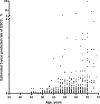Estimating Individualized Absolute Risk for Esophageal Squamous Cell Carcinoma: A Population-Based Study in High-Risk Areas of China
- PMID: 33489898
- PMCID: PMC7821851
- DOI: 10.3389/fonc.2020.598603
Estimating Individualized Absolute Risk for Esophageal Squamous Cell Carcinoma: A Population-Based Study in High-Risk Areas of China
Abstract
Background: Esophageal squamous cell carcinoma (ESCC) has a high incidence rate and poor prognosis. In this study, we aimed to develop a predictive model to estimate the individualized 5-year absolute risk for ESCC in Chinese populations living in the high-risk areas of China.
Methods: We developed a risk-predicting model based on the epidemiologic data from a population-based case-control study including 244 newly diagnosed ESCC patients and 1,220 healthy controls. Initially, we included easy-to-obtain risk factors to construct the model using the multivariable logistic regression analysis. The area under the ROC curves (AUC) with cross-validation methods was used to evaluate the performance of the model. Combined with local age- and sex-specific ESCC incidence and mortality rates, the model was then used to estimate the absolute risk of developing ESCC within 5 years.
Results: A relative risk model was established that included eight factors: age, sex, tobacco smoking, alcohol drinking, education, and dietary habits (intake of hot food, intake of pickled/salted food, and intake of fresh fruit). The relative risk model had good discrimination [AUC, 0.785; 95% confidence interval (CI), 0.749-0.821]. The estimated 5-year absolute risk of ESCC for individuals varied widely, from 0.0003% to 19.72% in the studied population, depending on the exposure to risk factors.
Conclusions: Our model based on readily identifiable risk factors showed good discriminative accuracy and strong robustness. And it could be applied to identify individuals with a higher risk of developing ESCC in the Chinese population, who might benefit from further targeted screening to prevent esophageal cancer.
Keywords: absolute risk; esophageal squamous cell carcinoma; high-risk area; individualized; prediction model.
Copyright © 2021 Shen, Xie, Zhao, Song, Shao, Hao, Niu, Ruan, Zang, Nakyeyune, Liu and Wei.
Conflict of interest statement
The authors declare that the research was conducted in the absence of any commercial or financial relationships that could be construed as a potential conflict of interest.
Figures



References
-
- Sun K, Zheng R, Zhang S, Zeng H, Zou X, Chen R, et al. Report of cancer incidence and mortality in different areas of China, 2015. China Cancer (2019) 28(1):1–11. 10.11735/j.issn.1004-0242.2019.01.A001 - DOI
LinkOut - more resources
Full Text Sources
Other Literature Sources

